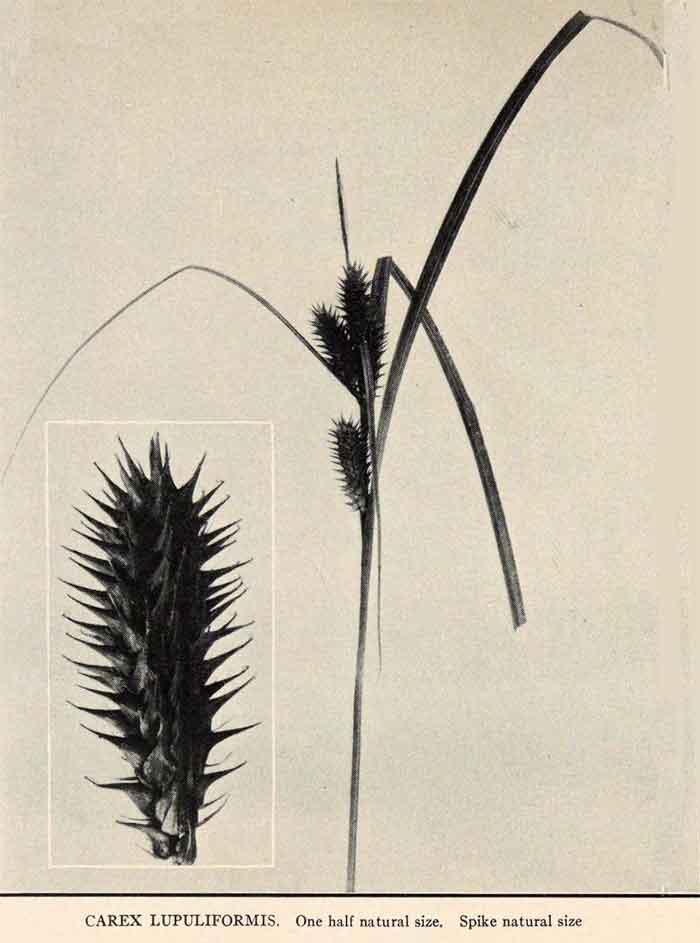Classification System: APG IV
Superregnum: Eukaryota
Regnum: Plantae
Cladus: Angiosperms
Cladus: Monocots
Cladus: Commelinids
Ordo: Poales
Familia: Cyperaceae
Subfamilia: Cyperoideae
Tribus: Cariceae
Genus: Carex
Species: Carex lupuliformis
Name
Carex lupuliformis Sartwell ex Dewey, Amer. J. Sci. Arts, ser. 2, 9: 29 (1850).
Distribution
Native distribution areas:
Continental: Northern America
Alabama, Arkansas, Connecticut, Delaware, Florida, Georgia, Illinois, Indiana, Iowa, Louisiana, Maryland, Masachusettes, Michigan, Minnesota, Mississippi, Missouri, New Jersey, New York, North Carolina, Ohio, Oklahoma, Ontario, Pennsylvania, Qubec, South Carolina, Tennessee, Texas, Vermont, Virginia, West Virginia, Wisconsin
References: Brummitt, R.K. 2001. TDWG – World Geographical Scheme for Recording Plant Distributions, 2nd Edition

References
Primary references
Sartwell, H.P. 1850. American Journal of Science, and Arts II, 9: 29 (1850).
Links
Govaerts, R. et al. 2020. Carex lupuliformis in Kew Science Plants of the World online. The Board of Trustees of the Royal Botanic Gardens, Kew. Published online. Accessed: 2020 Jan 23. Reference page.
International Plant Names Index. 2020. Carex lupuliformis. Published online. Accessed: Jan 23 2020.
Govaerts, R. et al. 2020. Carex lupuliformis in Kew Science Plants of the World online. The Board of Trustees of the Royal Botanic Gardens, Kew. Published online. Accessed: 2020 Jan 23. Reference page.
Tropicos.org 2020. Carex lupuliformis. Missouri Botanical Garden. Published online. Accessed: 23 Jan 2020.
Integrated Taxonomic Information System online database ITIS TSN: 39412
Vernacular names
English: false hop sedge
Carex lupuliformis, common name false hop sedge,[1] is a perennial sedge of sporadic distribution found in the floodplain forests and ephemeral woodland ponds[2] of central and eastern North America. The species typically produces four to seven leaves with sheaths of distal leaves of 3 to 21 cm whose ligules are rounded to triangular.[2] Carex lupuliformis blooms between early June and early October, typically with "two to six proximal female spikes, distal spikes usually crowded, ascending, densely flowered, usually cylindric, much longer than broad; one to two terminal male spikes."[2] Fruiting occurs between late July through early October. Fruit is described as "perigynia ascending to spreading, inflated, strongly veined, sessile, lance-ovoid, shiny, glabrous; beak conical; achenes stipitate, broadly diamond-shaped, scarcely if at all longer than wide, concave faces, angles thickened, prominently knobbed with hard, nipplelike points."[2]
Conservation status
Carex lupuliformis is listed at the state and provincial level as endangered or threatened throughout much of its northern range, whose upper limit is southern Ontario and Quebec. It is also listed as endangered on Schedule 1 of the Species at Risk Act in Canada.[3]
References
"Plants Profile for Carex lupuliformis (false hop sedge)". United States Department of Agriculture. Retrieved 10 June 2016.
"False Hop Sedge (Carex lupuliformis)". Wisconsin Department of Natural Resources. Retrieved 10 June 2016.
"Action Plan for the False Hop Sedge (Carex lupuliformis) in Quebec". Species at Risk Public Registry. Government of Canada. Archived from the original on 17 August 2016. Retrieved 10 June 2016.
Retrieved from "http://en.wikipedia.org/"
All text is available under the terms of the GNU Free Documentation License

_(3812893535).jpg/512px-False_hop_sedge_(Carex_lupuliformis)_(3812893535).jpg)
